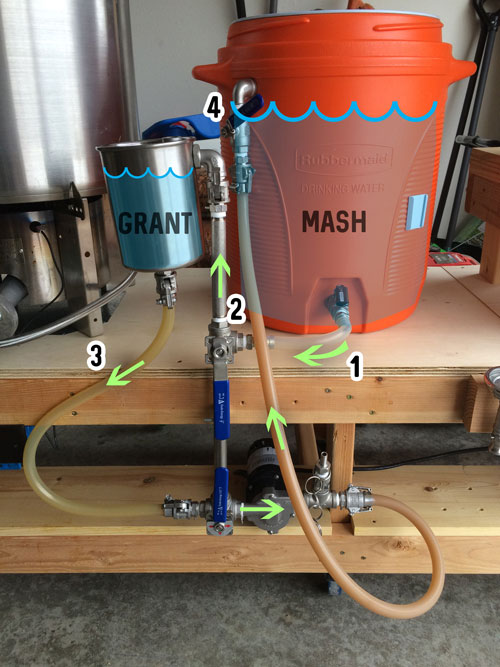How to make a grant
What is a grant?
A grant is a secondary vessel outside of the mash tun that controls, regulates and (in my case) filters the flow to the boil kettle.
Why use a grant?
Using a grant is a great tool when doing all grain brewing. First, its great for filtering. During your vorlauf you use this recirculation process to clear the runnings and to set the grain bed. With the addition of the grant, you are able to set filters in place to pick up any extra particles or husks. This also holds true when switching over to sparging. Typically the grain bed stays stable as long as your flow is consistent, but occasionally some junk can come through. Another great thing is the ability to control flow. Depending on your setup and where you place your grant, you can let gravity do the work! We can get more into the mechanics though later in this post.
Part List
For the grant itself your going to need a few parts.
- A small stainless container Amazon
- A primary filter (flour sifter) Amazon
- A secondary filter (tea infuser) Amazon
- 1/2” NPT stainless T fitting BarginFittings
- 1/2 Male NPT 3/8 Barb BargainFittings
- 3 x 1/2 Lockout Nuts BargainFittings
- 1/2 NPT Elbow BargainFittings
- 1/2 NPT Silicon Ring BargainFittings
For my setup, I have some optional fittings that might help. However, every setup is a little different. This is just my version of it.
- 1/2 NPT Camlock F BargainFittings
- 1/2 NPT Camlock B BargainFittings
Construction
Once you have the container, the first thing you need to do is cut some holes. This is probably the most difficult part of the process depending on what tools you have. It can be done with either a step bit or some kind of knockout punch, but the hole needs to be cut to about 13/16”. You will need to cut a hole on the side near the top and one on the bottom in the center.


The next step is to attach the bottom assembly. In my case I use camlocks, but any standard 1/2” threaded nipple would work. Use a locknut on the outside and on the inside to tighten. Be sure to put the silicon ring on the outside of the vessel.



After the bottom assembly is added, you can put in the filters. The first filter is the secondary filter. This filter grabs all of the tiny particles that might come through while vorlaufing. The next is the primary filter, which grabs most of the grain husks and larger particles that come through initially.




After the bottom assembly is added, we can mount up the top assembly. This portion will allow wort to run in a linear flow without adjustment.


After everything is assembled, you are ready to put your grant to use.

Putting it to use
Now lets see how we can actually use this. In this setup, I have my mash tun and grant sitting next to each other. My grant sits right under the level in which my mash is usually filled.

When starting the vorlauf, I am able to open up the valve fully and leave it. The hydrostatic pressure produced from within the mash tun will create a smooth and consistent linear flow. The rate of flow is then determined by the rate in which you add sparge water later on. Want it to go faster, sparge faster.
The hydrostatic pressure will push the wort up through the pipe and into the grant. Let gravity do all the work! Now the grant can start to filter our runnings.
Once the grant starts to fill, it will prime the pump. The pump will be used to pump the wort back up to the top of the mash tun.
The valve at the top of the mash tun will regulate the level of wort within the grant. Since the flow from the mash tun into the grant will be much slower than the flow the pump can produce, we need a way to slow that down. Otherwise, the pump would empty the grant and lose its prime.
How to make a grant





